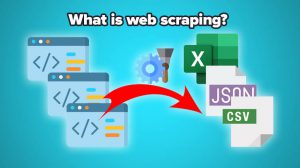
Web Scraping
Web scraping is the process of automatically collecting data from websites using automated scripts or tools. This data can include text, images, videos, links, and other content that is available on the website. Web scraping is commonly used for a variety of purposes, such as data mining, market research, content aggregation, price monitoring, and more.
To scrape a website, you need to write a program or script that sends HTTP requests to the website’s server and then parses the HTML or XML response to extract the desired data. There are many programming languages and libraries that can be used for web scraping, including Python, Java, Ruby, and others.
However, web scraping can be a controversial practice, as some website owners may consider it to be a violation of their intellectual property rights or a form of unauthorized data harvesting. Therefore, it’s important to respect website terms of service and copyright laws, and to use web scraping tools responsibly and ethically.
How to extract data from websites
To extract data from websites, you can use web scraping tools and techniques. Here are the general steps to extract data from a website:
-
Identify the website and the data you want to extract: First, you need to identify the website you want to scrape and the data you want to extract. This could be a list of products, contact details, or any other information.
-
Choose a web scraping tool or library: Next, you need to choose a web scraping tool or library. There are many options available, including Beautiful Soup, Scrapy, Selenium, and more. Each tool has its own strengths and weaknesses, so you should choose the one that best suits your needs.
-
Write the web scraping code: Once you have chosen a tool or library, you need to write the web scraping code. This involves sending HTTP requests to the website’s server, parsing the HTML or XML response, and extracting the desired data. You may also need to handle pagination, login authentication, and other issues that can arise during web scraping.
-
Store the data: Finally, you need to store the extracted data in a structured format such as CSV, JSON, or a database. You can then use this data for further analysis, visualization, or other purposes.
It’s important to note that web scraping can be a complex and challenging task, and you should be familiar with programming concepts and web technologies before attempting it. Additionally, you should always respect website terms of service and copyright laws, and use web scraping tools responsibly and ethically.
Advantages of web scraping
Web scraping is the process of automatically extracting data from websites. Here are some advantages of web scraping:
-
Data Collection: Web scraping allows you to collect data from websites on a large scale, which can be very useful for various applications like market research, data analysis, and competitor analysis.
-
Time-saving: Web scraping can save a lot of time by automating the data collection process, which can be done in a matter of seconds or minutes instead of hours or days.
-
Cost-effective: Web scraping can be cost-effective compared to other methods of data collection, such as hiring a team of researchers or purchasing data from third-party providers.
-
Customization: Web scraping can be customized to meet specific data requirements, such as selecting specific data fields or filtering out unwanted data.
-
Real-time Data: Web scraping can provide real-time data updates, which is particularly useful for monitoring stock prices, news articles, or social media trends.
-
Competitive Intelligence: Web scraping can help you gain insights into your competitors’ strategies, product pricing, and marketing tactics.
-
Decision-making: Web scraping can provide useful data for making informed decisions about business strategy, product development, and marketing campaigns.
Disadvantages of web scraping
While web scraping offers numerous advantages, it also has some potential disadvantages. Here are some disadvantages of web scraping:
-
Legal issues: Web scraping may violate copyright and intellectual property laws, and the terms of service of many websites prohibit web scraping. Using web scraping for illegal purposes can result in legal action and damage to your reputation.
-
Technical difficulties: Web scraping can be technically challenging, especially if you are working with complex websites that use JavaScript or require authentication. It may require significant expertise to overcome technical obstacles, and even then, the results may not be accurate.
-
Inconsistent Data Quality: Web scraping may result in inconsistent data quality, especially if the website structure changes frequently or if the data is presented in an unstructured format. This can lead to inaccurate analysis and decision-making.
-
Ethical concerns: Web scraping may raise ethical concerns, especially if it involves collecting personal information or scraping private information. It is essential to ensure that your web scraping activities are legal, ethical, and respect individuals’ privacy rights.
-
IP blocking: Websites may block web scraping activities by blocking the IP address of the scraper, which can make it difficult to collect data consistently.
-
Website performance: Web scraping can put a strain on website performance, which can result in slower load times, increased bandwidth usage, and server crashes.
-
Data overload: Web scraping can generate large amounts of data, which can be difficult to manage, process, and analyze. It is essential to have appropriate data management tools and techniques in place to handle the data generated from web scraping.
Master Your Coding Skills with BootSelf AI
If you're looking to enhance your coding abilities and upskill in artificial intelligence, look no further than the BootSelf AI app. This innovative platform provides AI-based coding lessons that are tailored to your individual learning pace.
Available on both iOS and Android, you can download the BootSelf AI app and start mastering coding skills today:




